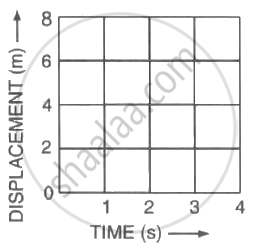Advertisements
Advertisements
प्रश्न
Obtain a relation for the distance travelled by an object moving with uniform acceleration in the interval between 4th and 5th seconds.
उत्तर
Let the object be moving with initial velocity u ms−1 and uniform acceleration an ms−2
∴ The distance travelled by the moving object
in ts is, s = `"ut" + 1/2 "at"^2`
Now distance travelled in 4s,
s4 = `"u" xx 4 + 1/2 "a" xx 4^2`
= 4u + 8a
Distance travelled in 5s
s5 = `"u" xx 5 + 1/2 "a" xx 5^2`
= `5"u" + 25/2 "a"`
∴ Distance travelled in the interval between 4th and 5th second
= `(5"u" + 25/2 "a") - (4"u" + 8"a")`
= `("u" + 9/2"a")"m"`
APPEARS IN
संबंधित प्रश्न
A particle is moving in a circular path of radius r. The displacement after half a circle would be :
Can displacement-time sketch be parallel to the displacement axis? Give a reason to your answer.
From the displacement-time graph of a cyclist given below in the Figure, find The displacement from the initial position at the end of 10 s,

Figure (a) shows the velocity-time graph for the motion of a body. Use it to find the displacement of the body at t = 1 s, 2 s, 3 s and 4 s, then draw on Figure (b), the displacement-time graph for it.
 |
 |
| (a) | (b) |
Is distance covered during nth second more than the distance covered in n seconds?
Name the physical quantity associated with the rate of change of displacement with time.
A particle moves along a circular path. How many times does it change its direction in two complete rounds?
A body moves along a circular path of radius r. When it completes three complete rounds, what is the ratio of distance covered to its displacement?
The table below shows the distance travelled by two vehicles A and B during each second:
| Time (s) | 0 | 1 | 2 | 3 | 4 | 5 | 6 | 7 |
| Distance travelled by A (m) | 0 | 20 | 80 | 180 | 240 | 300 | 360 | 420 |
| Distance travelled by B (m) | 0 | 10 | 40 | 90 | 160 | 250 | 360 | 490 |
Which vehicle is ahead at the end of 7th second and by how much?
A scalar quantity has ______.
